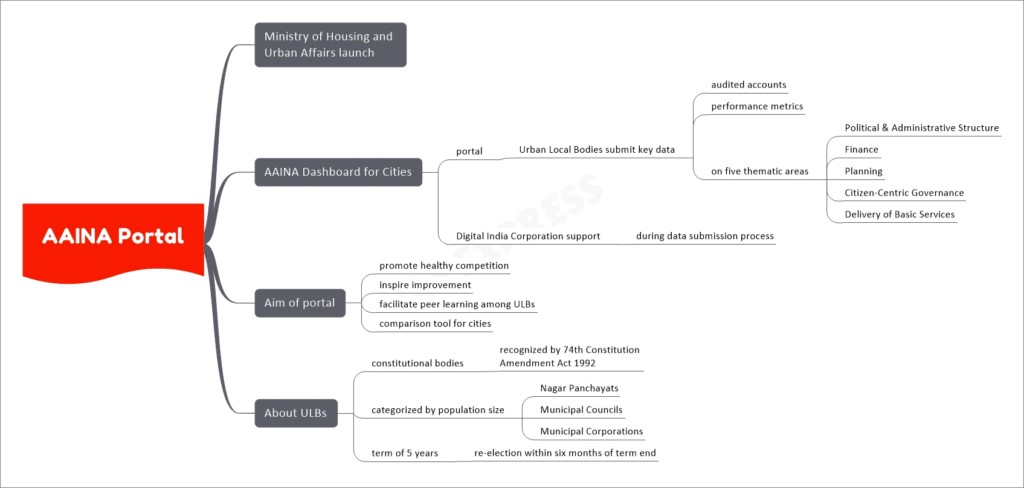Discussion about the SAI20 and AAINA Dashboard
SAI20
Why in News?
- The Comptroller & Auditor General of India (CAG) will chair SAI20, the Engagement Group for Supreme Audit Institutions (SAl) of G20 countries in Goa.
- The summit focused on setting priorities on Blue Economy and Responsible AI, encouraging collaboration and knowledge sharing among Supreme Audit Institutions (SAIs) (India’s SAI is CAG)
Role of CAG (Article 148)
- The history of the office can be traced back to 1858. In 1860 Sir Edward Drummond was appointed as the first Auditor General.
- CAG is appointed by President of India. Tenure is of 6 years or 65 years of Age. CAG can be removed by the President only in accordance with the procedure mentioned in the Constitution that is the manner same as removal of a Supreme Court Judge.
- Article 149 of the Indian Constitution authorises the Parliament to prescribe the duties and powers of the CAG. Therefore, in 1971 the central government enacted the Comptroller and Auditor General (Duties, Powers, and Conditions of Service) Act, 1971. The act made CAG responsible for both accounting and auditing duties for central and state governments. In 1976 CAG was relieved from accounting functions.
- He is the head of the Indian audit & account department and chief Guardian of public purse.
- It is the institution through which the accountability of the government and other public authorities (all those who spend public funds) to Parliament and State Legislatures and through them to the people is ensured.
- Article 279 – Calculation of “net proceeds” is ascertained and certified by the Comptroller and Auditor-General of India, whose certificate is final.
|
What is G20?
|
Priority Areas for the SAI20
- Two priority areas have been selected for deliberations; Blue Economy and Responsible Artificial Intelligence (AI).
- As Chair of SAI20, India’s CAG aims to help create a framework for G20 nations to ensure inter-generational equity and mitigate climate change while developing ocean resources.
- For SAI20, the CAG is to prepare technology-driven tools to assess authorised development in coastal stretches and track marine water quality.
What is Blue Economy:
- The concept was introduced by Gunter Pauli in his 2010 book- “The Blue Economy: 10 years, 100 innovations, 100 million jobs”.
- It is the sustainable use of ocean resources for economic growth, improved livelihoods and jobs, and ocean ecosystem health.
- It advocates the greening of ocean development strategies for higher productivity and conservation of ocean’s health
Primary Functions of SAIs
- SAI20 member countries are being engaged in a collaborative exercise to evolve globally relevant audit toolkits along with a compendium of case studies and challenges in the broader framework of auditing coastal spaces, which include:
- Legal and institutional frameworks,
- Compliance to coastal regulation,
- Biodiversity conservation,
- Capacity building and compliance to SDGs.
Conclusion:
The toolkit, crafted by SAI20 under the guidance of the Comptroller and Auditor General (CAG) of India, will be showcased during the SAI20 Engagement Group meeting. This event offers a distinct chance for productive discussions and consensus-building to enhance performance auditing in specific domains of ocean-based activities. This initiative aims to enhance the capabilities of auditors in SAI20 member countries and benefit regional auditing communities by offering a standardized and reproducible auditing tool.
AAINA Dashboard
Why in news?
The ‘AAINA Dashboard for Cities’ portal www.aaina.gov.in has been made live by Ministry of Housing and Urban Affairs (MoHUA) on 13th November, 2023 where Urban Local Bodies (ULBs) across the country can participate in this pioneering initiative to voluntarily submit their key data on a regular basis, through a simple, easy-to-fill, data entry form on the portal
What the Portal Aims for?
The portal promotes healthy competition, inspires improvement, and facilitates peer learning among ULBs. The dashboard for cities does not rank Urban Local Bodies. Instead, it functions as a tool for comparing cities in similar positions and fostering learning among them.
What is the ‘AAINA Dashboard for Cities’?
It is a portal that enables Urban Local Bodies (ULBs) to voluntarily submit key data, including audited accounts and performance metrics, on five thematic areas.
- Political & Administrative Structure
- Finance
- Planning
- Citizen-Centric Governance
- Delivery of Basic Services

Significance:
- Through this portal, Urban Local Bodies (ULBs) across the country can participate in this pioneering initiative to voluntarily submit their key data on a regular basis, through a simple, easy-to-fill, data entry form on the portal.
- The primary objectives of the AAINA Dashboard are to help cities to (i) see how they are faring vis-à-vis other cities, (ii) inspire them by pointing to possibilities and areas of improvement and (iii) providing opportunity to learn and engage with frontrunners.
- The dashboard for cities does not rank Urban Local Bodies (ULBs).
- The ULBs will submit their data, including audited accounts, and self-reported performance metrics by logging in to the dashboard’s portal.
|
Urban Local Bodies:
|
Data Submission Process:
- ULBs voluntarily submit key data regularly through an easy-to-fill data entry form on the portal.
- Data includes audited accounts and self-reported performance metrics.
- ULBs have the flexibility to update information as needed.
- Ministry, through Digital India Corporation, offers support to ULBs and states in the data submission process
Accessibility
- Once populated, the database of key performance metrics will be accessible to all stakeholders.
- The information will eventually be made public, promoting transparency and accountability.
Support Mechanism
The Ministry, through Digital India Corporation, will offer handholding support to ULBs and states during the data submission process
Conclusion
The AAINA Dashboard for Cities is a significant step towards creating a robust database of key performance metrics for ULBs. With active cooperation from all stakeholders, this initiative aims to foster transparency, accountability, and continuous improvement in urban governance
